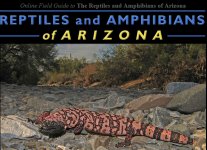| Range: |
 |
| Other Names: |
Chihuahuan Greater Earless Lizard |
| Subspecies: |
Southwestern Earless Lizard Cophosaurus texanus scitulus |
| Description: |
A medium-sized (up to 89 mm or 3.5" from snout to vent), gray or tan lizard with long, slender limbs and a flattened tail. The underside of the tail is marked with distinct black crossbands on a bright white background. The upper surfaces of the body are marked with tan, yellow, or peach spots surrounded by off-white or cream speckles. The groin, lower back, and forelimbs are often tinted yellow on males. The back of the thigh is marked with a dark horizontal line. There are two dark bars on each side of the belly that extend up onto the sides just in front of the hind limbs. On males these bars are surrounded by light blue patches on the belly. On females bars are faint or lacking. During breeding season females develop a pink throat patch and a peach or orange tint on the sides and flanks. The body scales are small and granular. As its common name implies, this lizard lacks external ear openings. |
| Similar Species: |
Lack of ears, coupled with the posterior position of its side bars distinguish the Greater Earless Lizard from the similar looking Zebra-tailed Lizard. |
| Venom: |
None |
| Habitat: |
The Greater Earless Lizard inhabits Semidesert Grassland, Interior Chaparral, and Great Basin Conifer Woodland communities. It is usually encountered above the flats on relatively open, gravelly slopes and along sandy drainages within mountainous terrain. |
| Behavior: |
This diurnal lizard is often encountered basking in the mid-morning sun. It hibernates during the cold months of winter and late fall. When approached by a predator it often curls and wags its tail over the back exposing the black and white stripes. This may be to let the predator know that it has been spotted by the lizard. If the predator knows it has been spotted it might not invest the energy required to chase this speedy lizard. When fleeing this lizard often runs with its tail curled over the back. This may serve to divert the predator’s attention to the tail (which can be regenerated). Both males and females are territorial and exhibit head bobbing, push-ups, and lateral compression of the body when approached by an outsider. |
| Hibernation: |
It hibernates underground during the cold months of winter and late fall. |
| Reproduction: |
This lizard mates in spring and lays one or more clutches of eggs in spring and summer. Clutch size ranges from 2 to 9 eggs. Hatchlings begin to emerge in July. |
| Diet: |
The Greater Earless Lizard feeds on a variety of insects including grasshoppers, butterflies, moths, bees, wasps, caterpillars, beetles, and ants. It also eats a variety of spiders.
|
Adapted from 
















